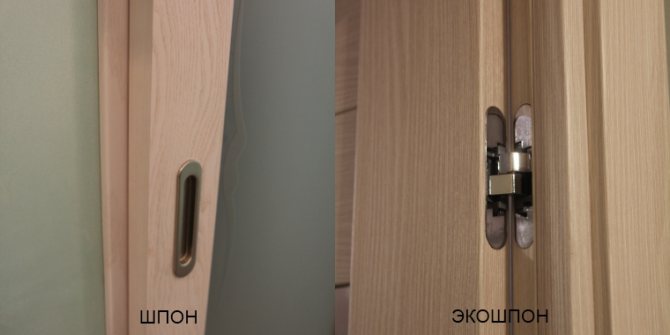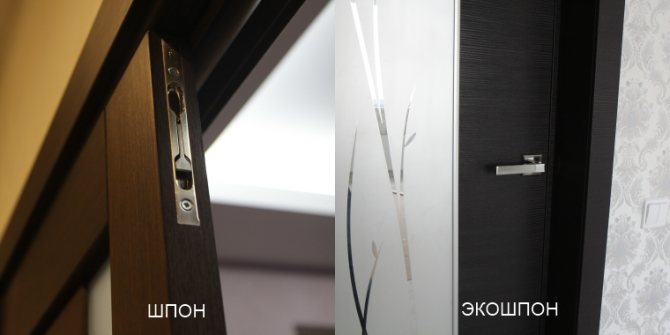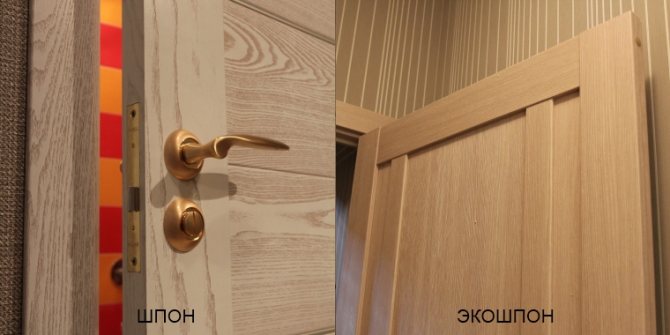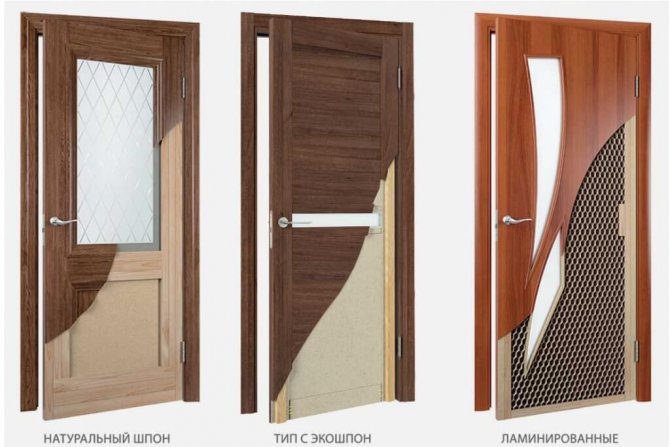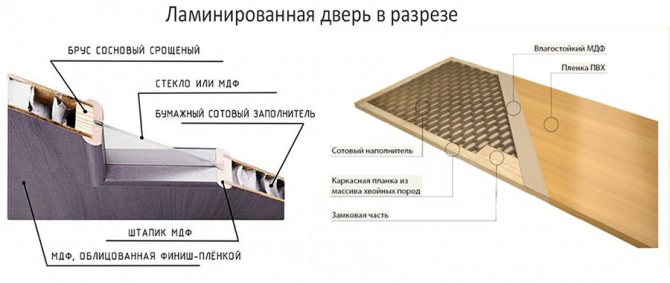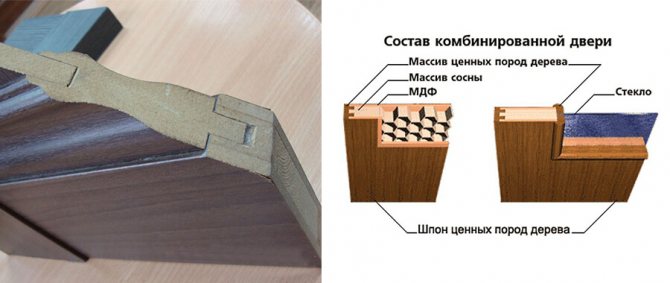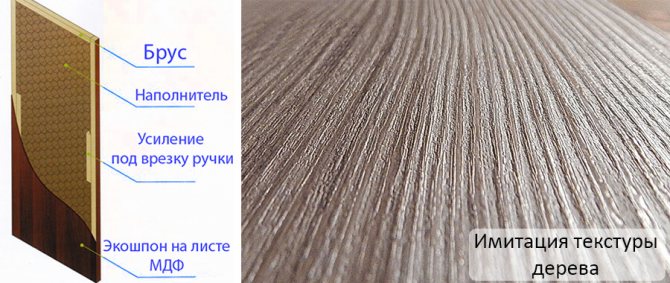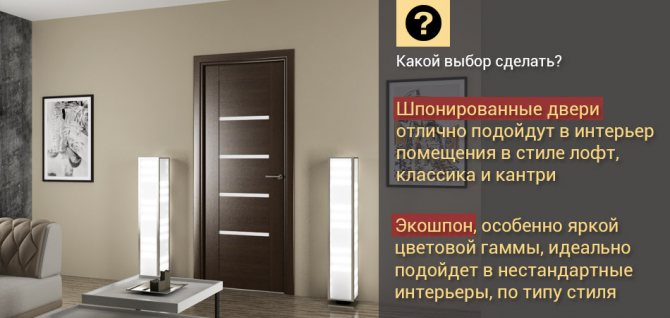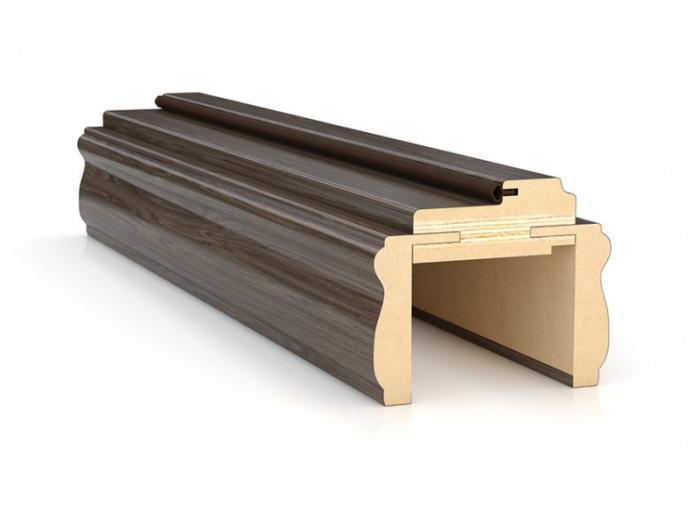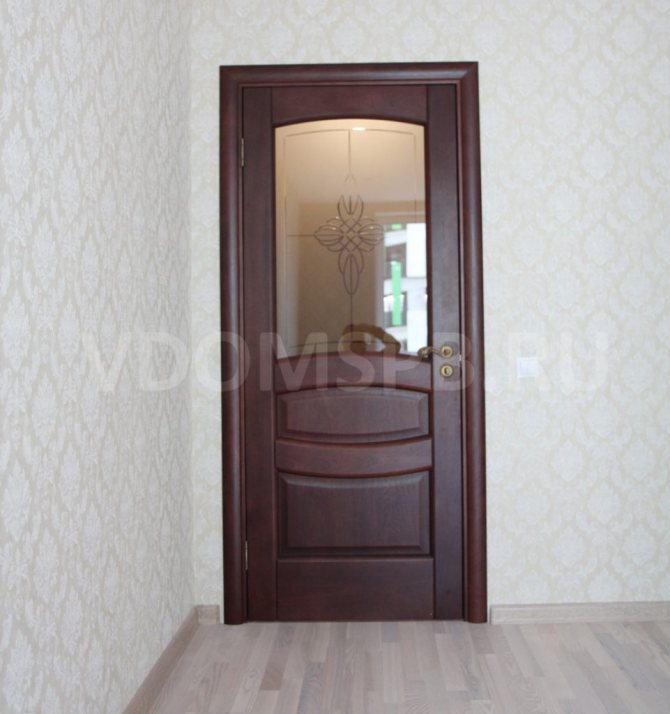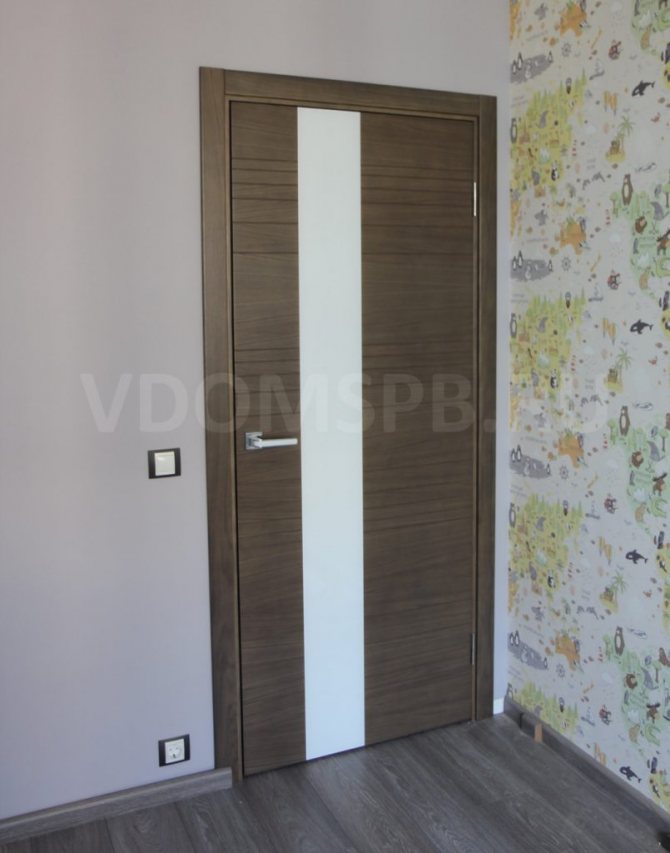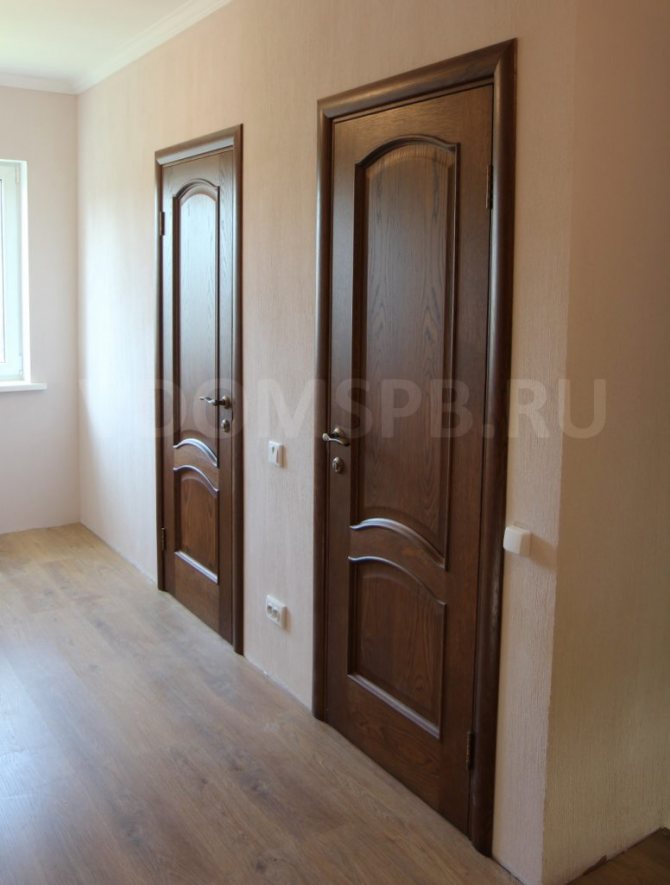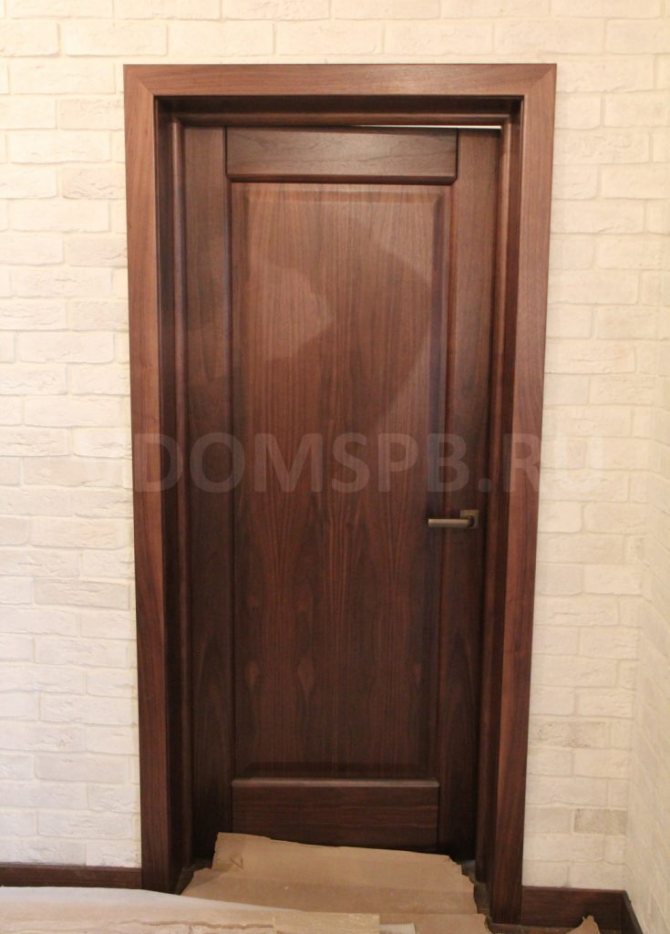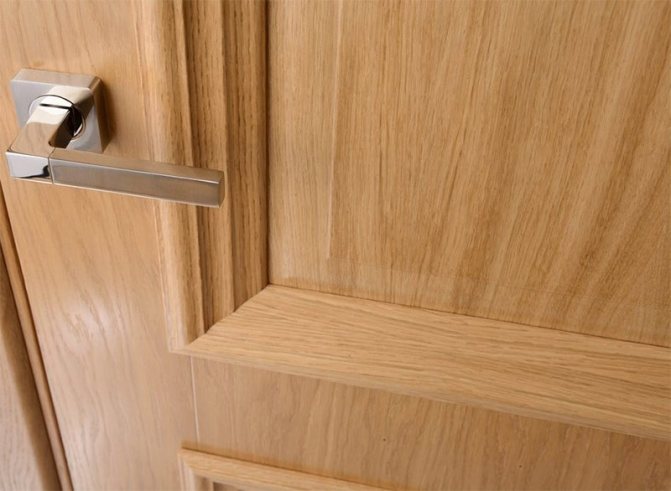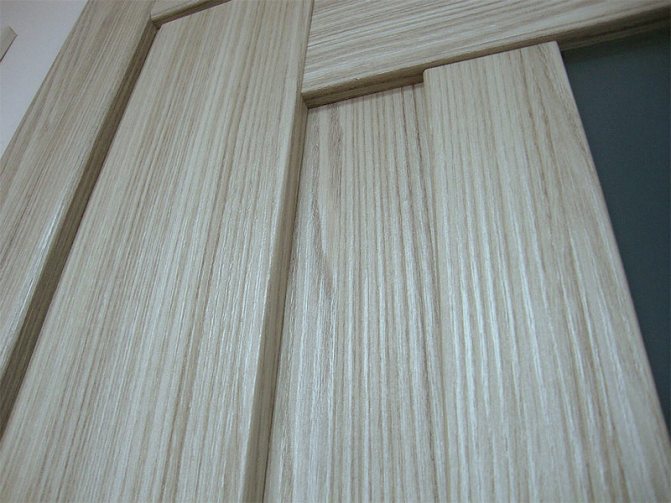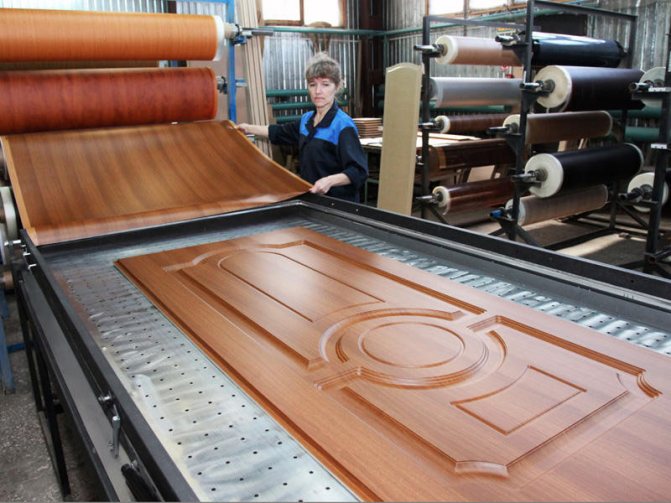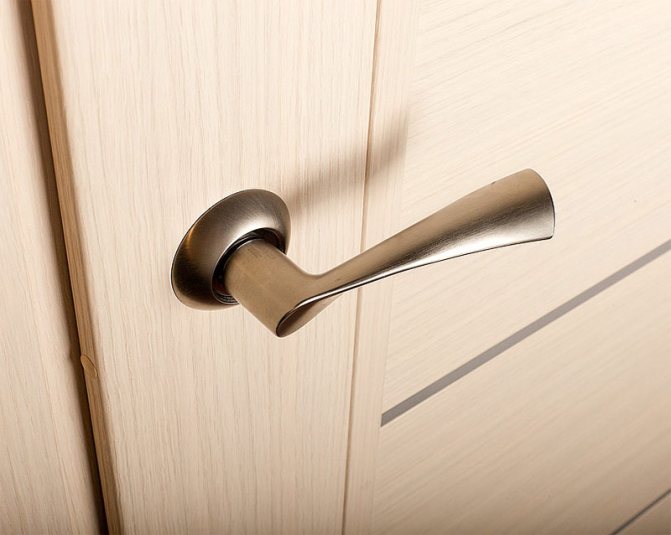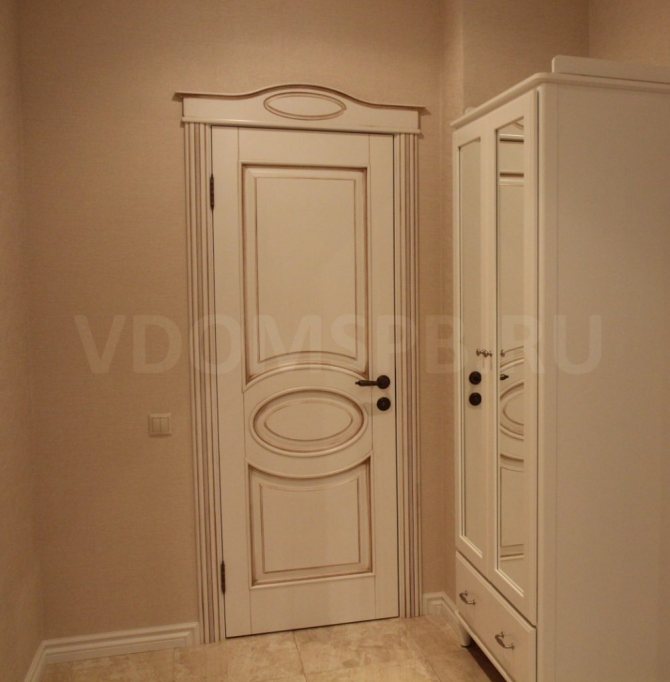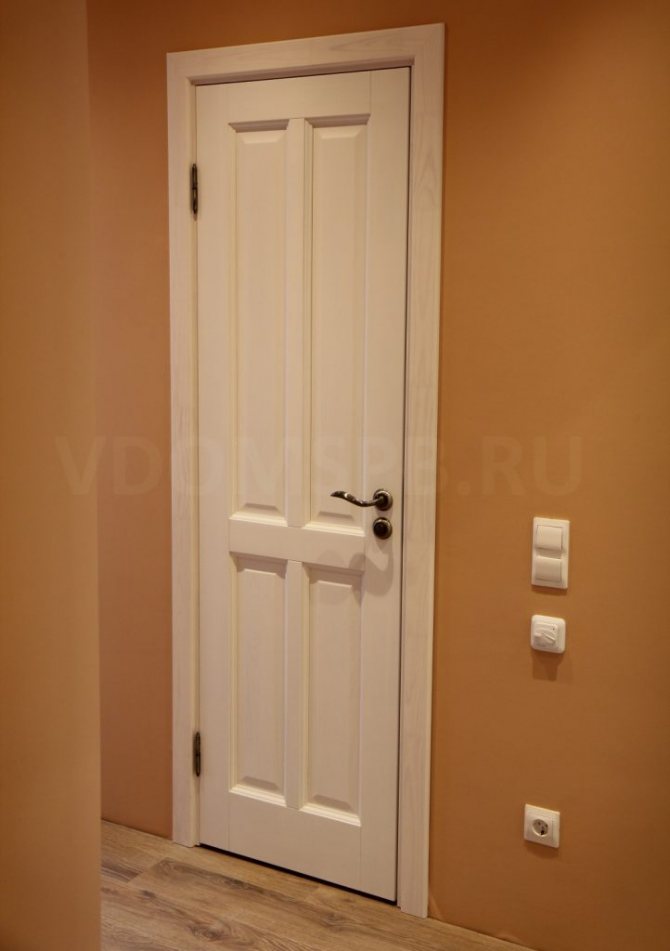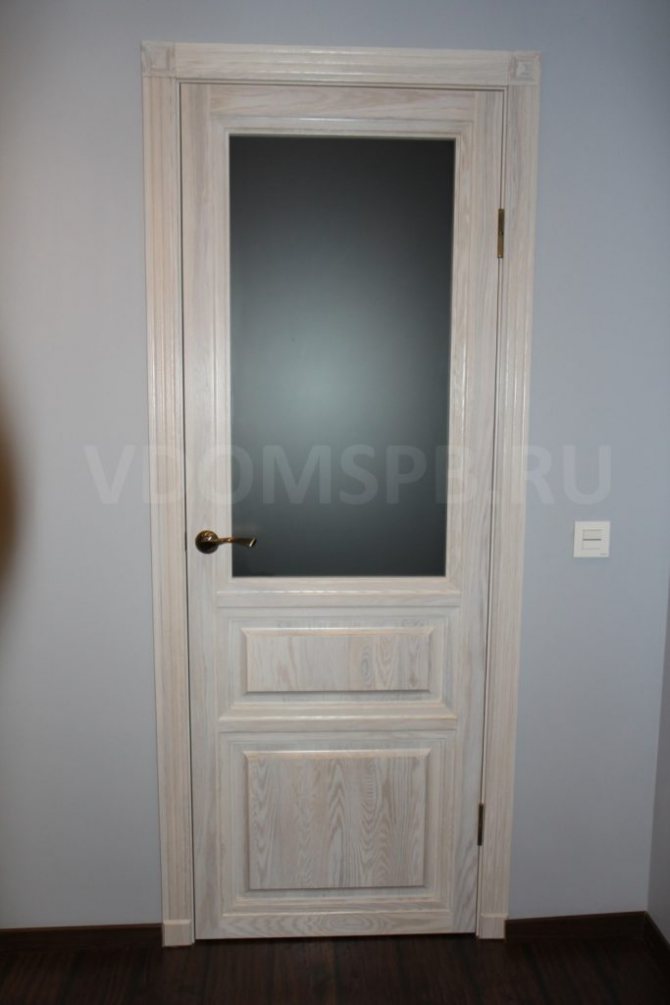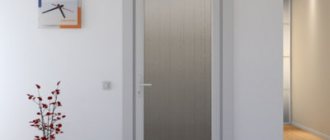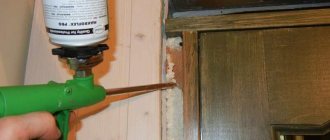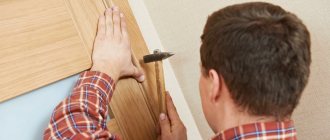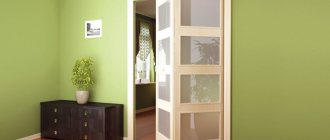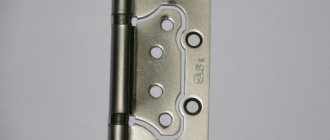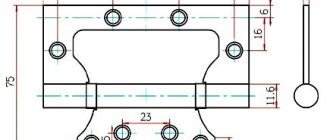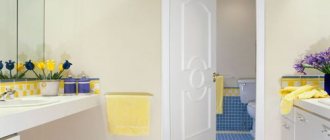When making repairs in an apartment, everyone wants to take into account everything to the smallest detail and make his dream come true. Manufacturing materials play an important role, and for such important interior items as doors, they generally stand almost in the first place. Eco-veneer is a fairly new material that has gained popularity in a short time. It could not be otherwise: people like the prefix "eco" by default. Today we will talk about the doors of their eco-veneer in the interior. You will learn to understand what is the difference between veneer and eco-veneer.
Interior doors eco-veneer
The question of what an eco-veneer is can be answered by decoding its second name - CPL. It translates as Continious Pressure Laminates, which in our native language sounds like this - subject to prolonged pressing.
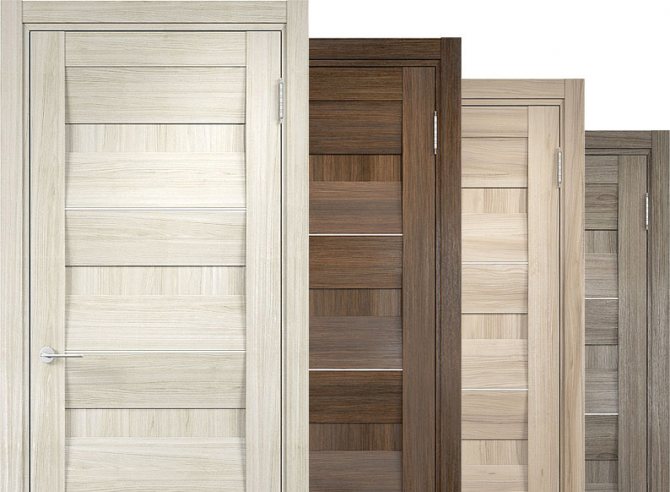
Eco-veneer is a polyurethane film that contains real wood shavings
Now we need to figure out what is being pressed for a long time - as mentioned above, it is a mixture of natural wood fibers and a synthetic binder. The structure of the obtained material has a unique volumetric effect, which misleads many people and makes them confuse natural veneer with artificial eco-veneer.
This material is produced in an interesting way - as is the case lately, only waste from the woodworking industry is used, which, with the help of special equipment, is broken into the smallest fibers. These very fibers are subsequently subjected to the process of dyeing and thorough mixing, after which they are glued together into a single thin coating, which is called an eco-veneer.
This technology for dyeing wood fibers eliminates differences in the dyeing of the finished product and gives it almost any shade that imitates the structure of any type of wood. The process of pressing this material itself is also interesting - it involves the use of a double-belt press, which does its work gradually.
With each subsequent step, the pressing force increases - this approach to business allows you to squeeze out even the smallest air bubbles from the mixture of sawdust and binder. As a result, at the end of the conveyor, a thin sheet material with high technical characteristics comes out - it is delivered from production in rolls and already at the door manufacturing plant is cut and applied to the products.
Strength and wear resistance
This is one of the main parameters that determines the service life of the doors. Usually, manufacturers try to improve this indicator by introducing new technologies.
Veneer... The main protection of such doors is provided by a layer of varnish with which they are covered, but in any case, scratches and dents that can appear to close up or mask it is quite difficult.
Laminate... Originally designed as a flooring, it is tough enough to resist cuts and dents. But for inexpensive doors, a material with a thin protective layer that can be susceptible to abrasion is often used.
Eco-veneer... Since it is created on the basis of polymeric materials, the wear resistance of the surface treated with it is at a high level - it does not crack, is not subject to chips and deformations. If natural veneer can change its appearance over time, then eco-veneer will retain its original appearance for two to three decades.Unlike products made from natural wood, eco-veneer is not susceptible to cracking and fading from ultraviolet radiation.
PVC foil... According to the technology, this material is literally baked on the surface, creating a durable coating. But when exposed to sharp objects, the film is easily damaged. Subsequently, it may lag behind the base.
If you do not take into account the quality of the materials used, eco-veneer and laminate are definitely in the lead in this category.
The difference between veneer and eco-veneer
Veneered doors are the undisputed sales leader in the interior doors segment. The veneer finish gives the door structures a presentable look, while they are relatively lightweight and have excellent functional characteristics. Veneered doors are easy to choose for any interior style; manufacturers offer a wide range of doors of various designs and colors.
What is veneer
Natural veneer is a thin cut of valuable wood species: oak, mahogany, walnut, cherry, beech and others. This material has long been used for the production of door structures. Recently, its artificial analogue, eco-veneer, has also become widespread. Interior doors made of eco veneer are in consistently high demand due to their aesthetic appearance and excellent durability.
In building stores and specialized salons, a wide assortment of interior doors made of eco-veneer is offered at prices that are quite affordable for the vast majority of buyers. There are several types of eco-veneer: the most common is polypropylene film; higher-class artificial facing materials, for example, nano-flex veneer, have also begun to gain popularity.
The nano-flex coating is made on the basis of high-strength Japanese parchment, which is covered with a durable polymer coating and a double layer of protective varnish. On the surface of nano-flex veneer, glossy and matt areas alternate, which creates a visual three-dimensional effect. To the touch, this material is identical to natural veneer - it is soft and velvety.
Polypropylene eco-veneer is produced by pressing a mixture of natural wood fibers and polypropylene. Outwardly, it looks almost indistinguishable from a natural veneer coating.
Advantages and disadvantages of eco-veneer
Comparing natural veneer and eco-veneer with each other, there are three main advantages of artificial turf:
- aesthetic appearance;
- high wear resistance;
- democratic cost.
Eco-veneer with 100% accuracy reproduces the natural cut of wood - both in texture and in color, it is practically indistinguishable from a natural coating.
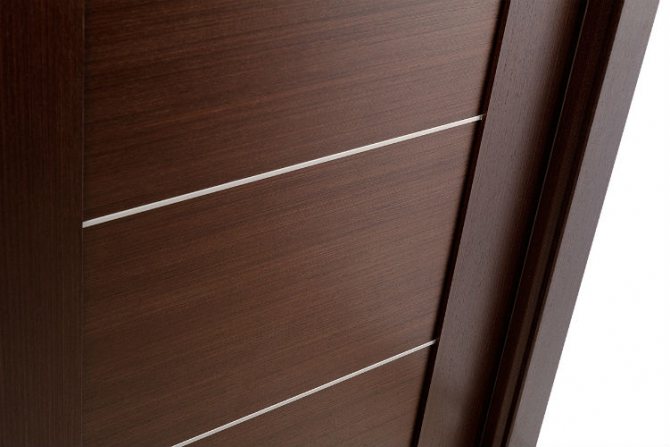

Eco-veneer with 100% accuracy reproduces a natural cut of wood and in texture and color scale it is practically indistinguishable from a natural coating
Artificial veneer is resistant to abrasion and other mechanical stress. It does not change its color during use, does not flake or crack under conditions of high humidity and temperature extremes.
Another advantage of the nano-flex eco-veneer is its environmental friendliness and hypoallergenicity, it contains no chlorine, heavy metals and formaldehyde. Caring for doors made of eco-veneer is as easy and simple as possible, they can even be washed with the use of detergents. The eco-veneer doors also have a number of disadvantages. Such a door leaf cannot be repaired in case of severe mechanical damage. And most importantly, eco-veneer is a material of artificial origin.
Advantages and disadvantages of natural veneer
Buy veneered interior doors are a worthy alternative to solid wood products.
Among their advantages:
- presentable view, indistinguishable from analogs from the array;
- the uniqueness of the design of each canvas;
- naturalness of the material;
- maintainability.
However, products with natural veneer have a higher cost, and also require gentle care with the use of special products. Which doors to stop on - each buyer solves this problem, based on his personal preferences and, of course, the budget allocated for repairs.
Prices for interior doors made of eco-veneer are low, so this solution is available even to buyers with a limited budget for repairs.
After all, the price of door leaves with artificial veneer is significantly lower than analogs with a natural coating, and, moreover, solid doors. Doors in natural veneer are more expensive, while they are not only as environmentally friendly as possible, but also have a noble natural pattern and lively energy.
Features and benefits
According to consumer reviews, in practice, eco-veneer is almost as good as a competitor made from natural raw materials. At the same time, products made from it will not fade in the sun, will not be destroyed due to the influence of environmental factors. Therefore, products made of eco-veneer can be installed in any premises.
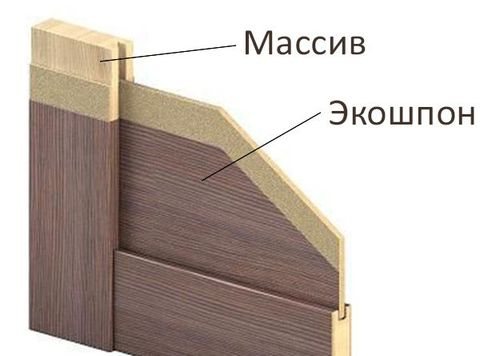

Door composition
Eco-veneer has a more resistant surface - resistant to ultraviolet light does not lend itself to deformation, for example, from clicks of latches, etc. Resistant to chemicals, household detergents for cleaning.
Difference between natural veneer and eco-veneer
Natural veneer is a thin cut of real wood, using which a unique structure and pattern of wood fibers ("annual rings") is obtained, which was inherent in the very wood from which this batch of veneer was made. This type of veneer is very practical due to its main properties: hardness, durability, flexibility and environmental friendliness.
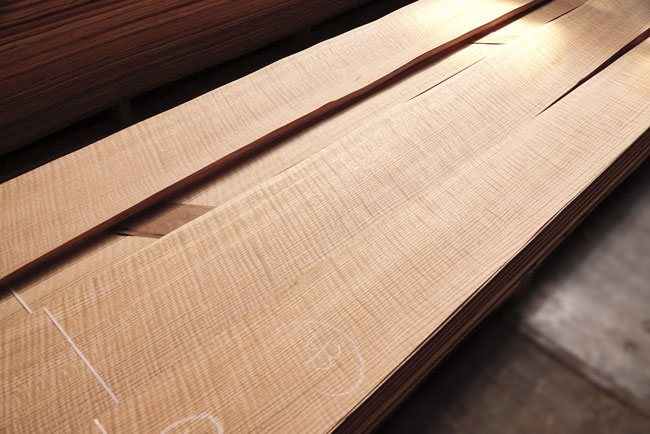

At first glance, the only thing that natural veneer and eco-veneer have in common is the surface texture
Eco-veneer is a polyurethane film that contains real wood shavings. Wood shavings are taken from wood waste and glued together under strong pressure with special polymer adhesives. The result is a smooth, homogeneous surface that imitates the structure of a tree.
It got its name "eco-veneer" only because, unlike other artificial coating options, it does not contain compounds of chlorides, heavy metals and formaldehydes. It is these elements that contain PVC films in large quantities. This characteristic has become the key reason why the consumer should give preference to “eco-veneer” among doors with any other artificial covering.
At first glance, the only thing that natural veneer and eco-veneer have in common is the surface texture. On the other hand, if you look closely at the surface of finished products, you can easily distinguish between natural and artificial. Eco-veneer will always have a fine, dense and repetitive texture and an almost smooth surface to the touch.
To reproduce the unique structure of annual rings, which affect the appearance and sometimes become a design leitmotif, repeating in several interior items, it is possible with the help of natural veneer (for example: doors, floors, furniture or kitchen facades, etc.). Please note that doors covered with eco-veneer are more difficult to restore than doors covered with natural ones.
Of course, if your budget is limited, we advise you to choose doors with eco-veneer. It has truly become an affordable alternative to natural materials. However, if you surround yourself with natural materials, want to get products as similar as possible to solid wood and just love prestigious things, doors covered with natural veneer will suit you.
Environmental friendliness
Practice shows that when deciding which interior doors to choose - laminated or veneered, made of PVC or eco-veneer, buyers do not pay as much attention to the issue of environmental friendliness as it is commonly believed. But we will consider these issues.
Veneer... It is presented as an environmentally friendly and breathable material that is harmless to humans. Some marketers add a third point here that the use of veneer reduces wood consumption. Questions arise at once on all of the above points. Firstly, who will give a guarantee that lacquer or glue was used in the production, which will not emit fumes in the future. Secondly, a varnished surface (and veneer is always varnished) cannot be breathable in any way. Thirdly, one must understand that it is not the consumption of wood that is decreasing, but the amount of its waste, which now goes into production.
Laminate... In fact, this is paper covered with a protective coating - if it is of high quality and is not subject to fumes, then there will be no harm to health from such a door.
Eco-veneer... According to the manufacturers, the material does not emit any fumes into the air, respectively, and will not release them outside if they begin to appear from the glue on the frame. It is difficult to say about the consumption of wood here, because its fibers are used in the production.
PVC foil... One of the components of this material is chloride, which is slowly but surely released into the air. The question remains whether this happens during the entire period of operation or within a certain time, but judging by the conclusion of the commissions about the permission to use this material and the number of installed plastic windows and doors, basically, this moment remains without due attention. Much more often it is mentioned that PVC is completely artificial material, and wood is not used in its production.
In terms of environmental friendliness, veneer wins with a slight advantage, but doors covered with eco-veneer and laminate with a high-quality coating are unlikely to be inferior to it. Here it is also necessary to pay attention to what kind of filling the door leaf itself has. The best option in terms of environmental friendliness would be doors, the frame of which is made of an array of low-value species, covered with veneer. If you choose between a frame made of chipboard and MDF, then MDF would be the best option, since it is a more environmentally friendly material.
Veneered doors or eco-veneer, which is better
Buying an interior door made of natural or artificial veneer, each of us thinks about its aesthetic and practical function. After all, the design should not only conveniently delimit the space and effectively separate the main work areas, but also harmoniously fit into the interior.
But an important factor in choosing the right interior door is the materials of manufacture and decoration, the quality of which determines whether the facade will dry out or fade, reliably protecting against noise and withstanding the action of moisture.
To varying degrees, the comfort of future operation will be provided by veneer and eco-veneer doors, which are better to buy after familiarizing yourself with the nuances of production, the advantages and disadvantages of each type.
Features of making doors from veneer and eco-veneer
The main difference between veneer door structures and eco-veneer is the use of various facing materials. In the first case, natural wood is used in the manufacture of doors, and in the second, an artificially created polymer (a type of plastic). As a basis for laying the topcoat, a bar of increased strength, MDF, as well as an array of coniferous wood acts.
In elite veneered models, such a canvas can be made in the form of a solid array, i.e. a workpiece spliced from several parts.For budget counterparts, a lighter, budgetary version of two sheets is made from eco-veneer, which are internally connected along the contour by strips, have stiffening ribs in the middle, and the cavities are filled with corrugated cardboard.
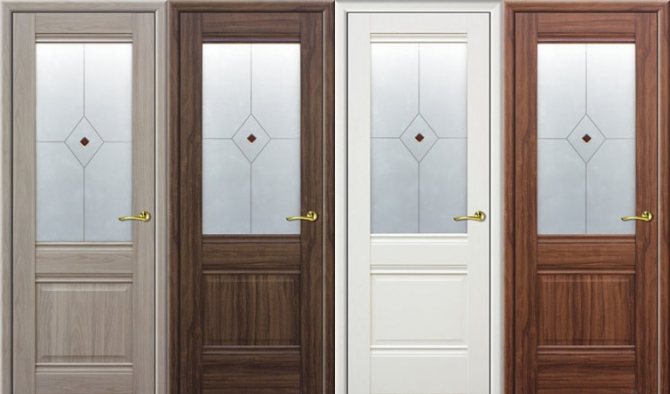

The main difference between veneer door structures and eco-veneer is the use of various facing materials
As a top layer, veneer or eco-veneer is applied to the facade of the door leaf. If the use of thin sheets of natural veneer material is envisaged, then hot pressing technology is used.
After strengthening on the basis of veneer strips, a moisture-resistant composition and varnish are applied to the surface, which ensures the completeness of the appearance and protects the product from mechanical damage. The eco-veneer is fastened after heating the film and applying it in a vacuum. The elastic material has excellent adhesion to each lug, tightly adhering to the surface.
The veneering of products is widely used not only in the manufacture of interior doors, but also in the decoration of furniture, wall partitions, etc. The use of veneer and eco-veneer leads to significant lightening and cheaper products, therefore the technology of imitation of solid wood is successfully introduced into production. An important advantage of the manufacture of veneered and eco-veneered doors is not just saving the resources used, but preserving forests from cutting down!
Table
| Veneer | Eco-veneer |
| What do they have in common? | |
| Eco-veneer is a material designed to replace, imitate veneer, which is used for cladding furniture, doors and other household items | |
| The surface of the materials has a similar appearance, characterized by the presence of woody patterns | |
| What is the difference between them? | |
| Is a natural material, made of wood | It is a synthetic material, it is a kind of plastic |
| It is used for the manufacture of plywood | Not applicable for the manufacture of plywood |
| Not too resistant to acids, alkalis, UV rays | Resistant to acids, alkalis, UV rays |
Eco-veneer doors in the interior
Eco-veneer is a material of artificial origin certified according to state standards, which very accurately repeats the texture and color of valuable wood species. The material is composed of wood fibers and polypropylene. Eco-veneer doors can have various design options.
Eco-veneer is made by pressing wood fibers and polypropylene under the influence of a certain temperature and pressure. The technology completely eliminates the appearance of gas and air bubbles, the material has no pores and becomes plastic like a film. In the form of rolls, finished products are delivered to the manufacturer.
This is the only technology that allows you to obtain a coating that is as close as possible in texture to the structure of natural wood. In the future, the door manufacturer uses a special technology to glue the eco-veneer on the door leaf. There is no reason to consider polypropylene as a dangerous polymer: it has been studied for a long time and is used even in the production of packaging for storing food products, and various containers for medical preparations.
Modification of doors made of eco-veneer
An interior door made of eco-veneer can have all kinds of modifications. The simplest design is a panel board, which has a flat door leaf, solid or with all kinds of inserts.
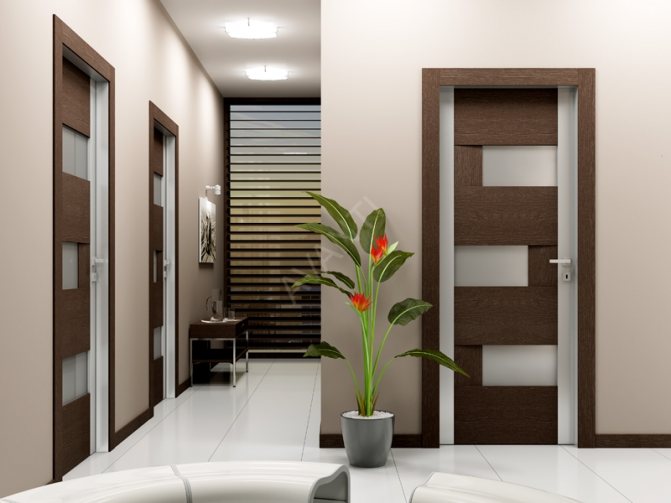

Door fittings must match the design of the door leaf and the interior of the room
The door can be made of solid wood or consist of a frame with a filler and outer skin. The filling can be solid or shallow. Solid filling makes the door more durable, and shallow-hollow filling greatly facilitates the construction.As a filler, the manufacturer can use plywood, fiberboard.
Paneled doors are often decorated with glass inserts. Such doors consist of a frame (solid or glued beams), thin inserts-panels made of chipboard, glass or plywood, which are placed in special grooves in the frame. There are aluminum frames to enhance the strength of the entire structure, especially if glass inserts make up a large area of the door. Less often, interior doors are made of plastic, covered with eco-veneer.
Glass inserts adorn doors and give them a festive feel, especially if they are colored décor. Colored decor on glass is performed using different technologies: artistic painting, lacquer pseudo-stained glass, stained glass, sandblasting, fusing.
Door fittings must match the design of the door leaf and the interior of the room. High-quality locks, handles and hinges are, first of all, ease of use. The cost of door hardware depends on the material from which it is made, manufacturing technology, type of coating. The reliability of the door is also due to the quality of the fittings.
Room designers and installers advise you to first buy the fittings and only then order the doors so that the master makes a "cut" and installs the hinges, locking mechanism and handles exactly to the size of the door leaf. It is not recommended to install door hardware on your own, it is better to entrust it to professionals. After all, having miscalculated by only 1 cm, you can ruin the door leaf or frame.
Advantages of zkoshpon
Eco-veneer has found its application not only in the production of interior doors. Kitchen furniture, chests of drawers, wall panels, stairs are made from it.
What are the performance characteristics of this material:
- the material realistically imitates many types of wood. The materials are visually and tactilely identical. The difference between veneer and wood is in price, the latter is several times more expensive;
- the material does not change its physical properties with changes in humidity and temperature, as it happens with natural veneer. And its moisture resistance and resistance to frequent satellites of wet rooms - mold and mildew, allows you to successfully install doors to the kitchen and bathroom;
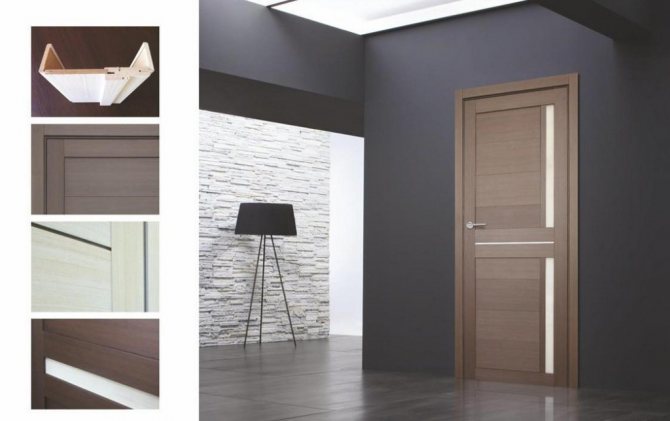

Eco-veneer has found its application not only in the production of interior doors, kitchen furniture is made of it, chests of drawers, wall panels, stairs
- eco-veneer painlessly transfers mechanical damage: scratches, chips. This is especially true for pet buyers;
- the material has no pores, therefore it is not contaminated;
- doors made of natural veneer may have a difference in shade in one batch, eco-veneer is devoid of such a drawback;
- in the manufacture of doors, the transverse and rack drawers are completely wrapped in an eco-veneer using the technology, which practically removes the issue of flaking, because the edge is always a weak point;
- harmlessness: polypropylene is a resistant material that does not interact with household chemicals during wet cleaning;
- the polymer is non-toxic throughout its entire service life. Even during combustion, it does not emit harmful chlorine compounds, which allows this material to be disposed of by incineration. Combustion produces carbon dioxide and water;
- the composition does not include heavy metals and formaldehydes, non-toxic plasticizers are used in the production. Therefore, interior doors and furniture made of eco-veneer are allowed to be used even in rooms for children;
- the composition does not include heavy metals and formaldehydes, non-toxic plasticizers are used in the production. Therefore, interior doors and furniture made of eco-veneer are allowed to be used even in rooms for children.
Doors made of eco-veneer, despite their resistance to moisture, cannot be installed in a sauna or steam bath.
Good choice
Modern manufacturers constantly surprise with innovative discoveries. This also applies to door coatings.As an alternative to traditional veneered doors, eco-veneer models have been created that are resistant to temperature extremes, do not dry out, and cracks do not form on their coating.
What is an eco-veneer for a modern person? This is a material that fully meets all the expectations of the consumer. It is environmentally safe, made from natural wood fibers, which are tightly bonded to each other in the process of special technological processing. Interior door structures made of such material can be installed anywhere due to their special resistance to any aggressive external environment, durability. Today their assortment is constantly expanding. You can successfully choose a model for any interior of a house, apartment, office.
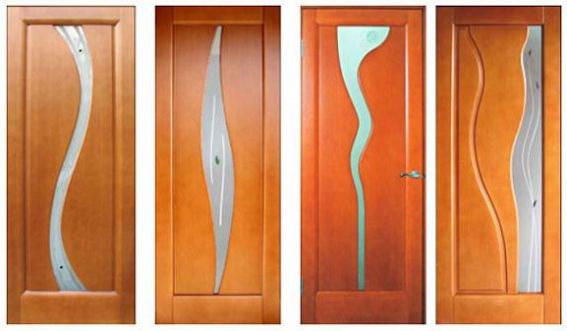

Comparison of different door coatings
| Veneer | Eco-veneer | Laminate | PVC foil | |||||||
| Environmental friendliness | Natural material, but glue is used to apply it. | Artificial material containing wood fibers. | Artificial material, but high-quality coating is environmentally friendly. | One of the components is chloride, which is released into the air. | ||||||
| Strength and wear resistance | The main strength is provided by the protective varnish and the reliability of the coating depends on its quality. | Possesses high wear resistance. | If the coating is of high quality, then it resists the formation of scratches and dents well. | It is easy to damage with sharp objects, after which peeling from the base can be observed. | ||||||
| Response to humidity and climate change | They are very moody, peeling from the base can be observed under the influence of moisture. | Not susceptible to moisture and temperature changes. | Resists moisture, but if the layer is damaged, it starts to deteriorate. | Does not absorb moisture. | ||||||
| Practicality and complexity of care | Requires special care. | There are no special requirements, but it should be remembered that the surface is embossed. | There are no special requirements, but it should be remembered that the surface is embossed. | The surface has no pores, can be washed with detergents. | ||||||
| Coating design and appearance | The texture and color of natural wood. | They have the texture of natural wood, while the color can be any. | It is possible to apply any images, but mainly under the wood texture. | Variety of colors and designs, but close inspection shows that it is a film. | ||||||
| Door cost | High. | Lower than veneer. | Average. | Low. | ||||||
If you notice an error, not a working video or a link, please select a piece of text and click Ctrl + Enter.
0
Coating design and appearance
None of the materials for the outer coating of door leaves impose any significant restrictions on their design. Doors can be paneled, with glass, other decorative inserts or with drawing on its surface.
Veneer... The surface has a characteristic woody pattern - most often it is varnished, less often it is painted.
Laminate... Manufacturing technology allows you to apply any pattern to the surface, but mostly buyers choose monochromatic wood-like colors.
Eco-veneer... Mostly this is a design of monochromatic colors with a structure of the outer coating characteristic of wood. In addition to the fact that eco-veneer imitates a wood structure, its advantage is the ability to paint the surface in different colors during production and get, for example, blue wood. At the same time, the colors for different doors will be exactly the same.
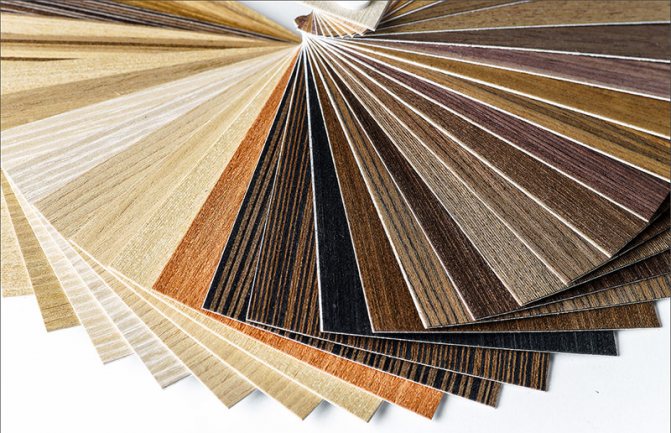

PVC foil... The manufacturing technology does not impose any restrictions on the color and design of such doors, especially since it is possible to use relief embossing. PVC coated doors can be made very similar to solid wood or veneer structures, which allows them to be used together with such models in the same interior.
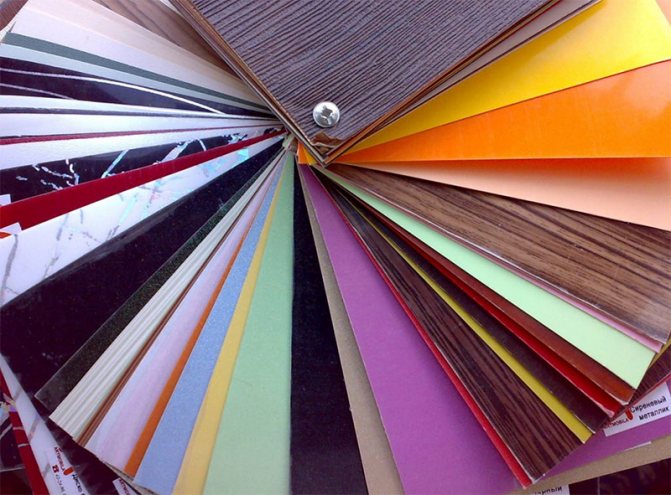

A feature of coatings made from natural materials is the heterogeneity of their colors - the color tone of doors, even from the same batch, may differ slightly. At the same time, no coating can convey the beauty of natural wood except veneer and eco-veneer.
Response to humidity and climate change
Here it is necessary to take into account not only the finish, but also what the door frame is made of - an array of glued wood bars or chipboard and MDF. In the first case, the effect of humidity and temperature will be much more noticeable.
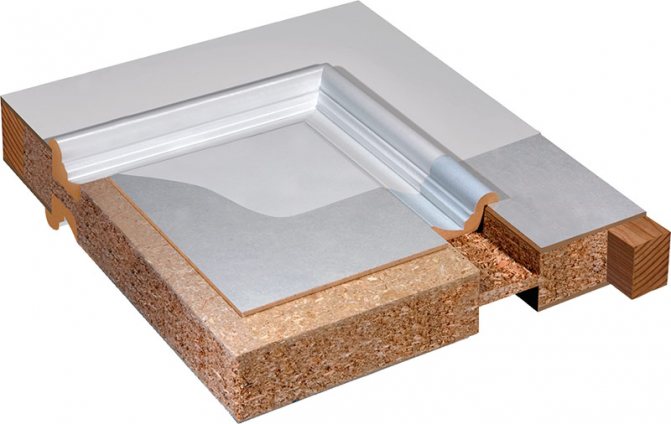

Veneer... In any case, such doors are not recommended to be installed in rooms with high humidity. If the frame is made of solid wood, then it will be susceptible to temperature changes.
Laminate... It tolerates moisture well, but if the outer layer is damaged, it will begin to deteriorate.
Eco-veneer... The material is not susceptible to moisture and temperature changes. These doors are recommended to be installed in the bathroom and toilet.
PVC foil... Plastic absolutely does not absorb liquid and is not subject to deformation under the influence of temperature, therefore it can be installed not only in damp, but also in technical, unheated rooms. In conditions of variable humidity and temperature, such doors will retain their shape unchanged.
According to this parameter, artificial materials win, and there is no particularly noticeable difference between them.
